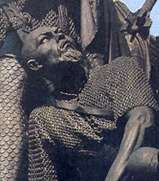Mamai
Mamai (Tatar: Мамай, Mamay; 1335–1380), of Kiyat descent, was a powerful military commander of the Golden Horde. Contrary to popular misconception, he was not a khan (king), but a warlord and a kingmaker for several khans, and the de facto regent of the Horde in the 1370s. His defeat in Battle of Kulikovo marked the beginning of the decline of the Horde, as well as his own.
| Mamai | |
|---|---|
| Beylerbey | |
 A statue of Mamai as part of Millennium of Russia monument | |
| Predecessor | ? |
| Successor | Edigu |
| Born | 1335 |
| Died | 1380 (aged 44–45) Caffa, Gazaria, Crimea |
| Burial | Şeyh Mamay (today Aivazovske, Kirovske Raion, Crimea) |
| Spouse | Berdi Beg's daughter (name unknown) |
| Issue | Khan Mamatsios, or Khan Mamatsu |
| Dynasty | Kiyat |
| Religion | Sunni Islam |
Viceroy of Crimea
Mamai became governor, sometime in the second half of the 1350s, of a territory that later would become the Crimean Khanate. During the rule of Berdi Beg (1357–59) Mamai was appointed as beqlar beg (beylerbey), a position simultaneously combining the duties of general of the army, minister of foreign affairs, and the head of the supreme court.
Interregnum after the assassination of Berdi Beg
Upon the assassination of Berdi Beg by Qulpa in 1359, Mamai associated himself with one of the coalitions formed to depose Qulpa. During that period of time the Golden Horde was in relative chaos; numerous regional governors were striving to become the Khan. Qulpa eventually was killed by Nawruz Beg who was himself assassinated less than six months later. Mamai, who was not a direct descendant of Genghis Khan, played a key role in promoting and supporting rival khans of the White Horde (western part of Golden Horde). In 1361 he supported Ğabdullah, son of Uzbeg Khan, who became Khan in Crimea. Upon the death of Ğabdullah in 1370, Mamai supported Bulak under regency of Tulun Beg Khanum, who only briefly enjoyed power before being replaced by his main opponent Urus in 1372.
Attempts to subdue the Principalities of Rus
After being badly defeated by Russians under Dmitri Donskoi first in 1378 at the Battle of the Vozha River and then at the Battle of Kulikovo (1380), Mamai began to assemble a large force to punish Dmitri. But he was defeated by Tokhtamysh on the banks of the Kalka River and was either executed by Tokhtamysh or assassinated by the Genoese after fleeing to Caffa.[1] The death of Mamai paved the way for the next khan to reunify the Golden Horde.
Legacy
The memory of Mamai has endured for centuries. Contemporary Russian language has an expression "как Мамай прошёл" (kak Mamaj prošjol), which translates roughly to "it's as if Mamai came through here", used to describe an utter mess.
The burial of Mamai was found by the native Crimean and famous Russian painter Ivan Aivazovsky. Mamai was buried in a village of Şeyh Mamay (today Aivazovske, Kirovske Raion).
Purported descendants
Khan Mamatsios or Mamatzios, Mamatsou,Mamatsu (Mamai-son) Macedonie was a supposed son of Mamai. One of his sons, Manzur Kiyat, purportedly escaped to Lithuania, and, serving Grand Prince Vytautas the Great, received the title of Prince of Hlinsk with multiple estates around the modern city of Poltava (Ukraine). These legendary events could have taken place in the 15th century, although the first documented mention of the Glinski princes is made in 1437. Michael Glinski was the most illustrious member of the family: he studied at the German university, took part as a knight in the Italian Wars, was the most powerful man in Lithuania in the 16th century, but later rebelled and run away with his brothers to Muscovy and helped the Russians to retake the city of Smolensk. His niece Elena Glinskaya was married to Vasily III, Grand Prince of Moscow, and Ivan the Terrible was her son.
References
- Janet Martin, Medieval Russia, 980-1584, (Cambridge University Press, 1995), 237.
| Preceded by Nogai Khan |
Military Leader of Blue Horde 1361 – 1380 |
Succeeded by Edigu |